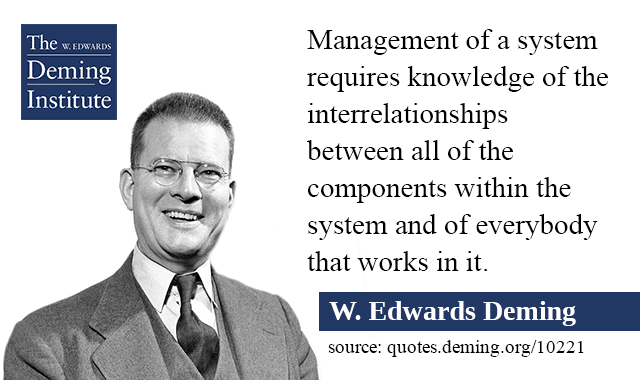Guest post by John Hunter, author of Management Matters: Building Enterprise Capability.
TJ Gokcen,CEO of Acquate, shared a presentation at our 2015 International Deming Research Seminar on Aim as a System.

In the presentation TJ says that one of management’s responsibilities is to coordinate communication between the interconnected components of a system.
Ensuring that feedback is shared with the parts of the system that need that information is something that sounds obvious and may not seem complicated but it is a challenge that many organizations have great difficulty with.
The effort to make this happen adds costs to the organization. Determining which costs are worth taking on and which (while they potentially may be worthwhile) should be avoided (because the benefit is not worth the cost) is a challenge.
The aim of the system sometimes may require management to change the boundaries of the components and therefore redefine them. And this is important because every system has a boundary and you determine these boundaries. These boundaries are not natural, actually management defines them.
…
It is also [of] utmost importance not to wait until a crisis or problem arises or merely react to circumstances to define the boundaries of a subsystem.
Often we resort to looking at the organization chart to “define” boundaries (really it isn’t defining boundaries, rather it is just defaulting decisions and blame to parts of the hierarchy without understanding the systems involved). This is easy but it is not a wise way to manage when you understand system thinking concepts and instead view the organization as a system.
TJ’s talk of the importance of a shared understanding and commitment to the aim of the organization reminds me of a presentation at our 2012 conference that explores that idea in depth: Hallmark Building Supplies: Applying Deming as a Business Strategy. Ideas such as culture and aim are powerful but they are difficult to appreciate and often people have a bad impression of the value because the implementation is often so poor. In many organizaiton you will hear talk with those words, but it has no impact on how the organization functions.
A shared aim and a culture that values continual improvement and respect for people can be powerful drivers for management improvement. But when talk of culture, values and aim doesn’t actually drive management practice within the organization they don’t provide value. Instead they result in people thinking of Dilbert and being trapped just like Dilbert is. The aim, culture, values… must guide action in order to provide value.
Unsolicited customer complaints are your best customers because they value your product or organization so much that they take the time [out] of their day to call you or write to you to give you their feedback.
I have written about this idea previously: Be Thankful for Customer That Are Complaining, They Haven’t Given Up All Hope.
Read TJ’s paper: Aim as a System.
Related: Developing Software Using Deming’s Ideas – Create Constancy of Purpose – Purpose of an Organization – Applying Quality as a Business Strategy at Hallmark Building Supplies – Transforming Jet-Hot by Viewing the Organization as a System



